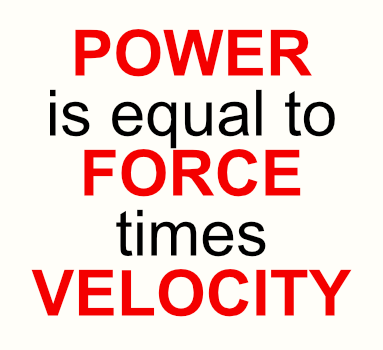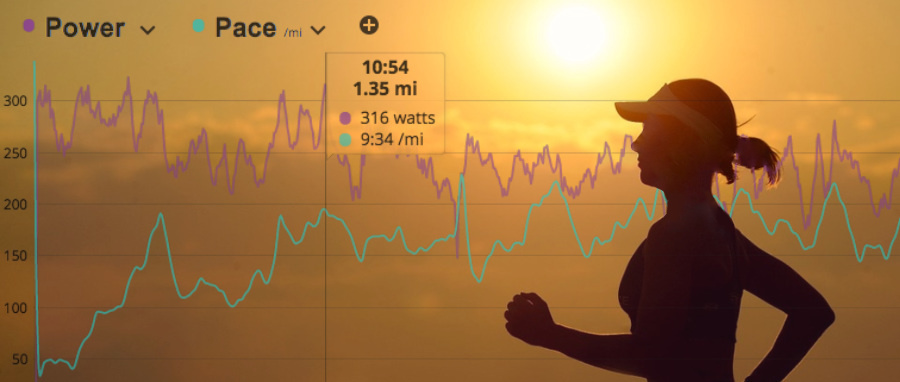Running with a Power Meter
A clear explanation of the benefits of using a power meter in running
If you want to be as competitive as possible in running — power is a metric you shouldn't ignore. In cycling, power is widely accepted as being critically important, but in running it's a brand-new frontier. But, even in these early days, power meters are proving to be effective tools for runners seeking an edge.
The goal of this article is to clearly explain some of the ways a power meter can help you improve your running performance, without using overly complex language. This subject tends to get extremely technical extremely quickly, but that's not what you'll find here.
The essence of running with a power meter is simple. When you run, your body has to work to propel itself forward. A power meter simply measures how much work you’re doing, and how fast you’re doing it. The basic equation that's used to calculate power in cycling is the same in running: power is equal to force times velocity.

Force is the work your body does to move forward, velocity is the speed at which it happens.
This may seem somewhat similar to pace, but power is completely different. Pace is a time-based metric that estimates how long it will take you to run a mile or a kilometer. Power is presented in watts, and it gives you an idea how much energy you're using (similar to an electrical meter on a building).
In running, pace is an extremely important tool for both training and racing — but it isn't perfect. A running power meter can fill some of the holes created by the shortcomings of pace. Using the two together makes for a potent combination.
Power and pace: a complimentary relationship
A well-trained runner knows that if they exceed or drop below a specific pace range for too long, that they will not perform at their full potential. The problem with pace is that it can be skewed by the variables of the environment. Hills, terrain, temperature, and wind all influence pace. If your plan is to maintain a 6:30/mile pace, you will need to work a lot harder to maintain it on a hilly course.
Power is impartial to these variables. When you run uphill with a power meter, you will immediately see your wattage increase. When you know your current threshold power number, you can precisely adjust your running intensity — in the moment — to match the changing demands of your environment.
Pacing uphill without power
The general rule of thumb for running uphill by pace is to use "perceived exertion" as your guide. The idea is that you should have a sense for how hard you've been working to hold your pace, and that you should try to maintain that level of exertion going uphill, even though your pace will be slower.
This is a long-standing method that has helped many runners successfully compete, but the problem is that it relies on the runner's awareness of their inner sensations, not on a quantified workout metric.
Pacing uphill with power
When you run uphill with a power meter, there is no guesswork involved with adjusting your intensity. A quick glance at your watch tells you exactly how hard you're working, and when you know your threshold power, you will know the precise wattage you need to maintain on the hill. You will be moving at a slower pace, but you will be expending a targeted amount of energy. You won't be over or under doing it.

Instead of viewing power as a replacement for other running metrics, think of it as a partner. Power supplies you with a reliable number that tells you exactly what's happening at the moment, regardless of the conditions and your health. It's a new and impressively accurate arrow in your quiver.
Fast and immediate feedback
Heart rate is a useful metric that can help you determine if your fitness is improving or declining, but one of its downsides is how detached it is from the dynamics of your workouts. When you start running it takes heart rate a long time to ramp up, and when you stop it can take just as long to settle down.
Pace is generally a much more responsive metric than heart rate, but it can still lag behind and suffer from inaccuracy — depending on the quality of your current GPS signal and/or the device you're using to monitor it.
Power is an extremely responsive metric that doesn't rely on GPS. For example, the Stryd running power meter not only supplies you with power data, it also measures remarkably accurate distance and pace metrics without GPS. If you're worried about dealing with inaccurate pace data on your GPS watch when running in an area with large buildings or other environments where satellite reception falters, the Styrd footpod is an attractive solution.
While the pacing data from Stryd is excellent, the real draw are the power metrics. You can monitor power in real-time for specific workouts, such as hill repeats, where you can immediately see how hard you're working, and more effectively gauge your performance comparatively. (You can also monitor 3-second, 10-second, and other kinds of averaged power when you use Stryd with Garmin watches that run Connect IQ apps.)
More examples of how running power meters are used
Shaving time off a personal record feels incredibly gratifying, and a running power meter can help make this happen. People often run the same routes over and over again, and if you train with a power meter, routine workouts like these can become valuable experimentation sessions. You can determine if changes in running form and equipment deliver beneficial results. Here are some examples:
Arm swing experimentation
It's no secret that running with a relaxed upper body is advantageous, but determining exactly how much you should swing your arms is a bit more mysterious. When running in identical conditions, intensities, and routes, you can intentionally experiment with your arm swing to see what delivers the fastest speeds using the least amount of wattage.
TIP: Be sure to leave detailed notes about these tests in your training log, such as utilizing the workout notes feature in SportTracks.
Find the most efficient shoe
It's common for runners to own more than one pair of running shoes, but it isn't common for them to identify which of their shoes are the most efficient for a specific terrain and condition. Running a half-marathon on primarily flat, smoothly-paved roads? Don't guess which of your shoes is the most power-efficient for this scenario, determine it.
Figuring out which shoes are best for which terrains and conditions is very similar to how you determine the fastest and most power-efficient arm swing. Test various kinds of shoes on identical routes with as similar conditions as possible, and analyze the data afterward to see which shoes delivered the most efficient runs.
Obviously, power-efficiency isn't the most important factor when deciding what shoes to wear. Fit and feel are still vital factors in shoe selection. But it's still helpful to know how your shoe choices impact your power efficiency on different terrains.
How to get started with running power
When you first start running with power, the numbers won't mean anything. But after you've accumulated data for several weeks and conducted basic, self-run tests to accurately determine your threshold power, things will start to change. Based on feedback from your power meter, and by regularly analyzing your power data, you can begin training to improve.
We strongly advise learning more about the topic if you get a running power meter. This blog post is intentionally focused on the basics; properly utilizing a power meter is more involved. We recommend reading Run with Power by coach Jim Vance (check out our review here). Running power demands a structured and methodical approach, and this book will guide you down the correct path.
It's important to have post-workout analysis software that's specifically geared for running power data. You need to monitor power as you run, but you also need to look at your data afterward to identify trends in your performance. SportTracks features the most built-in running power tools and metrics of any fitness platform, and on top of that, it's easy to use. You can start a 45-day free trial right now, and you won't be charged at the end.
...if you want new insights that can help you make incremental gains over time, start running with power now.
Final takeaways
This article provides just a small sampling of the benefits of running with power. This data can also be used to help you avoid injuries by overtraining, improve your running form, help you understand when your current training strategy has gone as far as it can go (and quickly gauge the effectiveness of any changes you implement), and much more.
A running power meter will not immediately make you a faster runner. You will only improve if you regularly analyze your power data, and purposely experiment with your running form, gear, and the intensity and specificity of your training.
The fact that running power meters remove the guesswork from pacing on hills makes them totally worthwhile, but there's so much more they can do. If you want new insights that can help you make incremental gains over time, start running with power now. It's quickly establishing itself as one of the most important metrics in endurance running.
| Article written by Sam Mallery, Director of Marketing, Zone Five Software Inc. |

